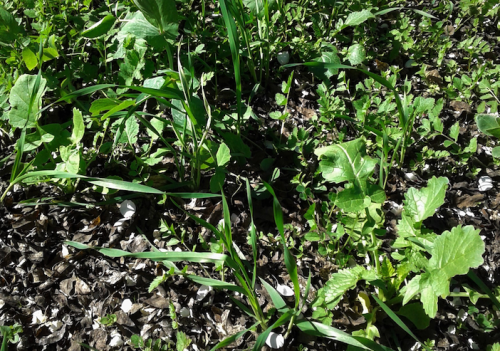
Farm Information
County: Yolo
Location: Winters, in the foothills of the Vaca Range, near 128.
Slope: n/a
Irrigation system: n/a
Soil type: Clay loam
Soil detail: n/a
Special farming challenges: some erosion/run-off issues
- Cropping Systems Information
- Crop: stone fruits, olives
Acres of orchard or vineyard: 100Other crops: no
Acres of other crops: n/a
Organic management: No
Certifications: None
Certifications notes: No certifications
Where using cover crops: Olives and prunes - Grower Experience, Farm Priorities, and Cover Cropping Goals
- When started farming (yr): Their family has been there since the 1950s. Started farming part time 1960s. Full time beginning mid 80s
Farm priorities: Sustainability. Conserving resources, building up the soil, using drip irrigation to be efficient, mimimizing chemical use and planting hedgerows for biodiversity and restoration/natural habitat. They are temporary guardians of the land. Don’t want to farm it cheaply.
Years growing orchard or vineyard crop: 3 generations for prunes. 11 years for olives.
Years growing cover crops: 19 years
Initial transition to cover cropping: Started with red clover under the more mature olives, but abandoned that as the tree canopy began to shade out the orchard floor.
Goals and benefits: Nitrogen supplement, soil improvement
Benefits description: Nitrogen fixation, reducing compaction, improving infiltration
Change in goals over time: CDFA Healthy Soils Program, now also include compost. And all much better for the soil. The other major transition has been to a no-till approach, using the cover crops to keep the soil open.
Reasons: If it doesn’t rain, cover crops are hard to keep up with due to weather. The mustard and radish are important to keep the soil open because they send their roots down. That is important so they can continue with no till/low till methods of growing. To cut back on discing, needed to keep the soil open using mustard. - Cover Crop Details, Planting and Management Methods
-
Block described here: Prunes, olives
Current cover crops: Legumes, grasses, brassicas
Species and mixes: Mustard, radish and multiplex mix
Planting method: Drill seed
Planting date (2020): Generally mid November
Was that optimal? Yes
Pre-plant soil prep: Disc (although uses no-till seeder, experience has shown that first doing a shallow discing loosens the soil and enables better survival of seeds being pressed down into the soil. With the seeds covered more effectively, there is less loss to birds.)
Planting equipment: 7 ft no-till seeder
Seeding rate: Unsure, maybe 50-60 lbs when adding brassicas to legumes?
Seeding depth: Not much depth since just pressed in for soil contact.
Did it germinate well? Yes, this year highly successful. but that's somewhat rare (1 out of every 3 or 4 years)
Additional management and advice: n/a - Cover Crop Termination Methods and Biomass Management
-
Termination method: Mow
Termination equipment and process: n/a
Termination date: n/a
Was it optimal? n/a
Biomass management: Left in place - Cover Cropping Challenges and Strategies to Address Them
- Challenges: Establishment difficulties
Challenges description: weather - lack of rain
Strategies to address challenges: none
Was the cover crop worth it? I think so, but hard to measure metrics.
Least successful past cover crops: Challenges with cover crops in the olives, such as clover, because they shade out the orchard floor year-round. This is a question of planting density and pruning/irrigation. Also, they are all drip, so if it doesn’t rain it’s a crapshoot. Get 1 out of 3 successful cover crop years, strictly due to weather.
